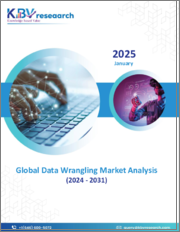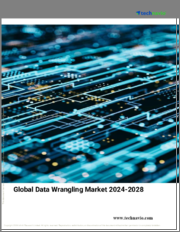
|
시장보고서
상품코드
1540868
세계의 데이터 랭글링 시장 보고서 : 컴포넌트별, 전개 모드별, 조직 규모별, 비즈니스 기능별, 업계별, 지역별(2024-2032년)Data Wrangling Market Report by Component, Deployment Mode, Organization Size, Business Function, Industry Vertical, and Region 2024-2032 |
||||||
데이터 랭글링 시장 규모는 2023년 30억 달러에 달했습니다. 향후 IMARC 그룹은 시장이 2032년까지 106억 달러에 이를 전망이며, 2024년과 2032년 사이에 14.6%의 복합 연간 성장률(CAGR)을 나타낼 것으로 예측했습니다.
데이터 랭글링은 정리되지 않은 데이터를 변환하고 매핑하여 의미 있는 분석 인사이트을 얻는 것을 의미합니다. 여기에는 고급 알고리즘을 사용하여 데이터 시각화 및 집계를 위해 원시 데이터를 정리, 재구성 및 강화하는 작업이 포함됩니다. 데이터 랭글링 도구 및 솔루션은 온프레미스 또는 클라우드에 배포할 수 있습니다. 처리된 데이터는 또한 인공지능(AI), 머신러닝(ML), 데이터 분석 등의 고급 작업에 활용됩니다. 또한 재무, 마케팅, 영업, 운영, 인사(HR) 등 다양한 비즈니스 기능을 최적화할 수 있습니다. 결과적으로 데이터 관리 솔루션은 은행/금융서비스/보험(BFSI), 의료, 소매, 미디어, 제조, 정보 기술(IT) 등 다양한 산업에서 광범위하게 활용되고 있습니다.
데이터 랭글링 시장 동향 :
IT 업계의 현저한 성장과 데이터 처리 및 청소를 위한 효과적인 도구와 소프트웨어에 대한 수요 증가는 시장 전망을 밝게 하는 주요 요인 중 하나입니다. 게다가 소비자들 사이에서 데이터 신뢰성에 대한 우려가 커지고 있다는 것은 데이터 관리 솔루션 수요를 증가시키고 있습니다. 중소기업과 대규모 기업은 저품질 데이터 필터링, 분포 및 불일치 시각화, 조직 프로세스 개선에 이러한 솔루션을 활용합니다. 이에 따라 BFSI 기관은 데이터 보안 향상, 반구조화 및 비구조화 데이터 정리, 온라인 뱅킹 포털 최적화를 위해 데이터 랭글링 프로세스를 이용하고 있습니다. 또한 빅데이터와 엣지 컴퓨팅 솔루션의 도입 등 다양한 기술의 진보도 성장을 가속하는 요인이 되고 있습니다. 이러한 기술은 조직의 기능에 직접적인 영향을 미칠 수 있는 인시던트의 실시간 예측 및 모니터링을 용이하게 합니다. 그 밖의 요인으로는 급속한 디지털화, 광범위한 R&D 활동 등을 들 수 있으며 시장 성장을 뒷받침할 것으로 예상됩니다.
이 보고서에서 다루는 주요 질문
- 세계의 데이터 랭글링 시장의 2023년 시장 규모는?
- 세계의 데이터 랭글링 시장의 2024년부터 2032년 예상 성장률은?
- 세계의 데이터 랭글링 시장을 견인하는 주요 요인은?
- 세계의 데이터 랭글링 시장에 대한 COVID-19의 영향은?
- 세계의 데이터 랭글링 시장의 구성 요소별 고장은?
- 세계의 데이터 랭글링 시장의 전개 모드별 고장은?
- 세계의 데이터 랭글링 시장의 조직 규모별 내역은?
- 세계의 데이터 랭글링 시장의 비즈니스 기능별 고장은?
- 세계의 데이터 랭글링 시장의 업계별 내역은?
- 세계의 데이터 랭글링 시장의 주요 지역은?
- 세계의 데이터 랭글링 시장의 주요 기업은?
목차
제1장 서문
제2장 조사 범위와 조사 방법
- 조사의 목적
- 이해관계자
- 데이터 소스
- 1차 정보
- 2차 정보
- 시장 추정
- 상향식 접근
- 하향식 접근
- 조사 방법
제3장 주요 요약
제4장 소개
- 개요
- 주요 업계 동향
제5장 세계의 데이터 랭글링 시장
- 시장 개요
- 시장 실적
- COVID-19의 영향
- 시장 예측
제6장 시장 분석 : 컴포넌트별
- 솔루션
- 시장 동향
- 시장 예측
- 서비스
- 시장 동향
- 시장 예측
제7장 시장 내역 : 전개 모드별
- 온프레미스
- 시장 동향
- 시장 예측
- 클라우드 기반
- 시장 동향
- 시장 예측
제8장 시장 내역 : 조직 규모별
- 대기업
- 시장 동향
- 시장 예측
- 중소기업
- 시장 동향
- 시장 예측
제9장 시장 분석 : 비즈니스 기능별
- 금융
- 시장 동향
- 시장 예측
- 마케팅과 판매
- 시장 동향
- 시장 예측
- 오퍼레이션
- 시장 동향
- 시장 예측
- 인사
- 시장 동향
- 시장 예측
제10장 시장 분석 : 업계별
- BFSI
- 시장 동향
- 시장 예측
- 정부 및 공공 부문
- 시장 동향
- 시장 예측
- 헬스케어 및 생명과학
- 시장 동향
- 시장 예측
- 소매업 및 전자상거래
- 시장 동향
- 시장 예측
- 미디어 및 엔터테인먼트
- 시장 동향
- 시장 예측
- IT 및 통신
- 시장 동향
- 시장 예측
- 제조
- 시장 동향
- 시장 예측
- 기타
- 시장 동향
- 시장 예측
제11장 시장 분석 : 지역별
- 북미
- 미국
- 캐나다
- 아시아태평양
- 중국
- 일본
- 인도
- 한국
- 호주
- 인도네시아
- 기타
- 유럽
- 독일
- 프랑스
- 영국
- 이탈리아
- 스페인
- 러시아
- 기타
- 라틴아메리카
- 브라질
- 멕시코
- 기타
- 중동 및 아프리카
- 시장 동향
- 시장 분석 : 국가별
- 시장 예측
제12장 SWOT 분석
- 개요
- 강점
- 약점
- 기회
- 위협
제13장 밸류체인 분석
제14장 Porter's Five Forces 분석
- 개요
- 구매자의 협상력
- 공급기업의 협상력
- 경쟁도
- 신규 참가업체의 위협
- 대체품의 위협
제15장 가격 분석
제16장 경쟁 구도
- 시장 구조
- 주요 기업
- 주요 기업 프로파일
- ALTERYX INC.
- Altair Engineering Inc.
- Hitachi Vantara Corporation
- Impetus Technologies Inc.
- International Business Machines Corporation
- Oracle Corporation
- SAS Institute Inc.
- Teradata Corporation
- TIBCO Software Inc
- Trifacta Software Inc.
The global data wrangling market size reached US$ 3.0 Billion in 2023. Looking forward, IMARC Group expects the market to reach US$ 10.6 Billion by 2032, exhibiting a growth rate (CAGR) of 14.6% during 2024-2032.
Data wrangling refers to the transformation and mapping of unorganized data to gain meaningful analytical insights. It involves cleaning, restructuring and enhancing raw data for data visualization and aggregation using advanced algorithms. Data wrangling tools and solutions can be deployed on-premises or on the cloud. The processed data is further utilized for advanced tasks, such as artificial intelligence (AI), machine learning (ML) and data analytics. In addition, it can also be used for optimizing various business functions, such as finance, marketing, sales, operation and human resources (HR). As a result, data wrangling solutions find extensive applications across various industries, including banking, financial services and insurance (BFSI), healthcare, retail, media, manufacturing and information technology (IT).
Data Wrangling Market Trends:
Significant growth in the IT industry, along with the increasing demand for effective tools and software for data processing and cleaning, is one of the key factors creating a positive outlook for the market. Moreover, rising concerns regarding data veracity among the consumers are escalating the demand for data wrangling solutions. Small, medium and large-scale organizations use these solutions to filter low-quality data, visualize distributions and inconsistencies and improve the organizational processes. In line with this, BFSI institutions use data wrangling processes to improve data security, organize semi-structured and unstructured data and optimize online banking portals. Additionally, various technological advancements, such as the deployment of big data and edge computing solutions, are acting as other growth-inducing factors. These technologies facilitate real-time forecasting and monitoring of incidents that may have a direct impact on the functioning of the organizations. Other factors, including rapid digitization, along with extensive research and development (R&D) activities, are anticipated to drive the market toward growth.
Key Market Segmentation:
IMARC Group provides an analysis of the key trends in each sub-segment of the global data wrangling market report, along with forecasts at the global, regional and country level from 2024-2032. Our report has categorized the market based on component, deployment mode, organization size, business function and industry vertical.
Breakup by Component:
Solution
Service
Breakup by Deployment Mode:
On-premises
Cloud-based
Breakup by Organization Size:
Large Enterprises
Small and Medium Enterprises
Breakup by Business Function:
Finance
Marketing and Sales
Operations
Human Resources
Breakup by Industry Vertical:
BFSI
Government and Public Sector
Healthcare and Life Science
Retail and E-commerce
Media and Entertainment
IT and Telecom
Manufacturing
Others
Breakup by Region:
North America
United States
Canada
Asia-Pacific
China
Japan
India
South Korea
Australia
Indonesia
Others
Europe
Germany
France
United Kingdom
Italy
Spain
Russia
Others
Latin America
Brazil
Mexico
Others
Middle East and Africa
Competitive Landscape:
The competitive landscape of the industry has also been examined along with the profiles of the key players being ALTERYX INC., Altair Engineering Inc., Hitachi Vantara Corporation, Impetus Technologies Inc., International Business Machines Corporation, Oracle Corporation, SAS Institute Inc., Teradata Corporation, TIBCO Software Inc and Trifacta Software Inc.
Key Questions Answered in This Report
- 1. What was the size of the global data wrangling market in 2023?
- 2. What is the expected growth rate of the global data wrangling market during 2024-2032?
- 3. What are the key factors driving the global data wrangling market?
- 4. What has been the impact of COVID-19 on the global data wrangling market?
- 5. What is the breakup of the global data wrangling market based on the component?
- 6. What is the breakup of the global data wrangling market based on the deployment mode?
- 7. What is the breakup of the global data wrangling market based on organization size?
- 8. What is the breakup of the global data wrangling market based on the business function?
- 9. What is the breakup of the global data wrangling market based on the industry vertical?
- 10. What are the key regions in the global data wrangling market?
- 11. Who are the key players/companies in the global data wrangling market?
Table of Contents
1 Preface
2 Scope and Methodology
- 2.1 Objectives of the Study
- 2.2 Stakeholders
- 2.3 Data Sources
- 2.3.1 Primary Sources
- 2.3.2 Secondary Sources
- 2.4 Market Estimation
- 2.4.1 Bottom-Up Approach
- 2.4.2 Top-Down Approach
- 2.5 Forecasting Methodology
3 Executive Summary
4 Introduction
- 4.1 Overview
- 4.2 Key Industry Trends
5 Global Data Wrangling Market
- 5.1 Market Overview
- 5.2 Market Performance
- 5.3 Impact of COVID-19
- 5.4 Market Forecast
6 Market Breakup by Component
- 6.1 Solution
- 6.1.1 Market Trends
- 6.1.2 Market Forecast
- 6.2 Service
- 6.2.1 Market Trends
- 6.2.2 Market Forecast
7 Market Breakup by Deployment Mode
- 7.1 On-premises
- 7.1.1 Market Trends
- 7.1.2 Market Forecast
- 7.2 Cloud-based
- 7.2.1 Market Trends
- 7.2.2 Market Forecast
8 Market Breakup by Organization Size
- 8.1 Large Enterprises
- 8.1.1 Market Trends
- 8.1.2 Market Forecast
- 8.2 Small and Medium Enterprises
- 8.2.1 Market Trends
- 8.2.2 Market Forecast
9 Market Breakup by Business Function
- 9.1 Finance
- 9.1.1 Market Trends
- 9.1.2 Market Forecast
- 9.2 Marketing and Sales
- 9.2.1 Market Trends
- 9.2.2 Market Forecast
- 9.3 Operations
- 9.3.1 Market Trends
- 9.3.2 Market Forecast
- 9.4 Human Resources
- 9.4.1 Market Trends
- 9.4.2 Market Forecast
10 Market Breakup by Industry Vertical
- 10.1 BFSI
- 10.1.1 Market Trends
- 10.1.2 Market Forecast
- 10.2 Government and Public Sector
- 10.2.1 Market Trends
- 10.2.2 Market Forecast
- 10.3 Healthcare and Life Science
- 10.3.1 Market Trends
- 10.3.2 Market Forecast
- 10.4 Retail and E-commerce
- 10.4.1 Market Trends
- 10.4.2 Market Forecast
- 10.5 Media and Entertainment
- 10.5.1 Market Trends
- 10.5.2 Market Forecast
- 10.6 IT and Telecom
- 10.6.1 Market Trends
- 10.6.2 Market Forecast
- 10.7 Manufacturing
- 10.7.1 Market Trends
- 10.7.2 Market Forecast
- 10.8 Others
- 10.8.1 Market Trends
- 10.8.2 Market Forecast
11 Market Breakup by Region
- 11.1 North America
- 11.1.1 United States
- 11.1.1.1 Market Trends
- 11.1.1.2 Market Forecast
- 11.1.2 Canada
- 11.1.2.1 Market Trends
- 11.1.2.2 Market Forecast
- 11.1.1 United States
- 11.2 Asia-Pacific
- 11.2.1 China
- 11.2.1.1 Market Trends
- 11.2.1.2 Market Forecast
- 11.2.2 Japan
- 11.2.2.1 Market Trends
- 11.2.2.2 Market Forecast
- 11.2.3 India
- 11.2.3.1 Market Trends
- 11.2.3.2 Market Forecast
- 11.2.4 South Korea
- 11.2.4.1 Market Trends
- 11.2.4.2 Market Forecast
- 11.2.5 Australia
- 11.2.5.1 Market Trends
- 11.2.5.2 Market Forecast
- 11.2.6 Indonesia
- 11.2.6.1 Market Trends
- 11.2.6.2 Market Forecast
- 11.2.7 Others
- 11.2.7.1 Market Trends
- 11.2.7.2 Market Forecast
- 11.2.1 China
- 11.3 Europe
- 11.3.1 Germany
- 11.3.1.1 Market Trends
- 11.3.1.2 Market Forecast
- 11.3.2 France
- 11.3.2.1 Market Trends
- 11.3.2.2 Market Forecast
- 11.3.3 United Kingdom
- 11.3.3.1 Market Trends
- 11.3.3.2 Market Forecast
- 11.3.4 Italy
- 11.3.4.1 Market Trends
- 11.3.4.2 Market Forecast
- 11.3.5 Spain
- 11.3.5.1 Market Trends
- 11.3.5.2 Market Forecast
- 11.3.6 Russia
- 11.3.6.1 Market Trends
- 11.3.6.2 Market Forecast
- 11.3.7 Others
- 11.3.7.1 Market Trends
- 11.3.7.2 Market Forecast
- 11.3.1 Germany
- 11.4 Latin America
- 11.4.1 Brazil
- 11.4.1.1 Market Trends
- 11.4.1.2 Market Forecast
- 11.4.2 Mexico
- 11.4.2.1 Market Trends
- 11.4.2.2 Market Forecast
- 11.4.3 Others
- 11.4.3.1 Market Trends
- 11.4.3.2 Market Forecast
- 11.4.1 Brazil
- 11.5 Middle East and Africa
- 11.5.1 Market Trends
- 11.5.2 Market Breakup by Country
- 11.5.3 Market Forecast
12 SWOT Analysis
- 12.1 Overview
- 12.2 Strengths
- 12.3 Weaknesses
- 12.4 Opportunities
- 12.5 Threats
13 Value Chain Analysis
14 Porters Five Forces Analysis
- 14.1 Overview
- 14.2 Bargaining Power of Buyers
- 14.3 Bargaining Power of Suppliers
- 14.4 Degree of Competition
- 14.5 Threat of New Entrants
- 14.6 Threat of Substitutes
15 Price Analysis
16 Competitive Landscape
- 16.1 Market Structure
- 16.2 Key Players
- 16.3 Profiles of Key Players
- 16.3.1 ALTERYX INC.
- 16.3.1.1 Company Overview
- 16.3.1.2 Product Portfolio
- 16.3.1.3 Financials
- 16.3.2 Altair Engineering Inc.
- 16.3.2.1 Company Overview
- 16.3.2.2 Product Portfolio
- 16.3.2.3 Financials
- 16.3.2.4 SWOT Analysis
- 16.3.3 Hitachi Vantara Corporation
- 16.3.3.1 Company Overview
- 16.3.3.2 Product Portfolio
- 16.3.4 Impetus Technologies Inc.
- 16.3.4.1 Company Overview
- 16.3.4.2 Product Portfolio
- 16.3.5 International Business Machines Corporation
- 16.3.5.1 Company Overview
- 16.3.5.2 Product Portfolio
- 16.3.5.3 Financials
- 16.3.5.4 SWOT Analysis
- 16.3.6 Oracle Corporation
- 16.3.6.1 Company Overview
- 16.3.6.2 Product Portfolio
- 16.3.6.3 Financials
- 16.3.6.4 SWOT Analysis
- 16.3.7 SAS Institute Inc.
- 16.3.7.1 Company Overview
- 16.3.7.2 Product Portfolio
- 16.3.7.3 SWOT Analysis
- 16.3.8 Teradata Corporation
- 16.3.8.1 Company Overview
- 16.3.8.2 Product Portfolio
- 16.3.8.3 Financials
- 16.3.8.4 SWOT Analysis
- 16.3.9 TIBCO Software Inc
- 16.3.9.1 Company Overview
- 16.3.9.2 Product Portfolio
- 16.3.9.3 SWOT Analysis
- 16.3.10 Trifacta Software Inc.
- 16.3.10.1 Company Overview
- 16.3.10.2 Product Portfolio
- 16.3.1 ALTERYX INC.



















